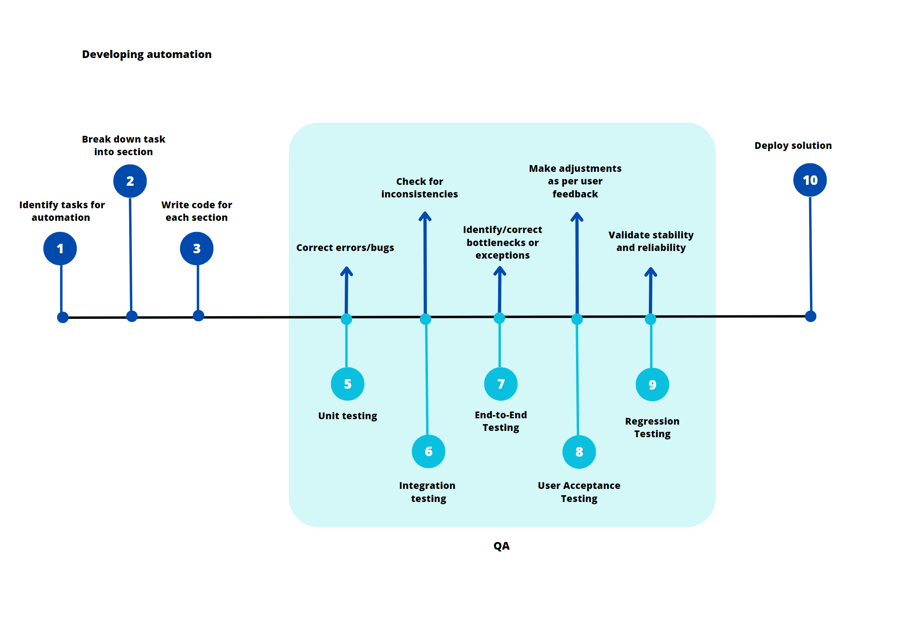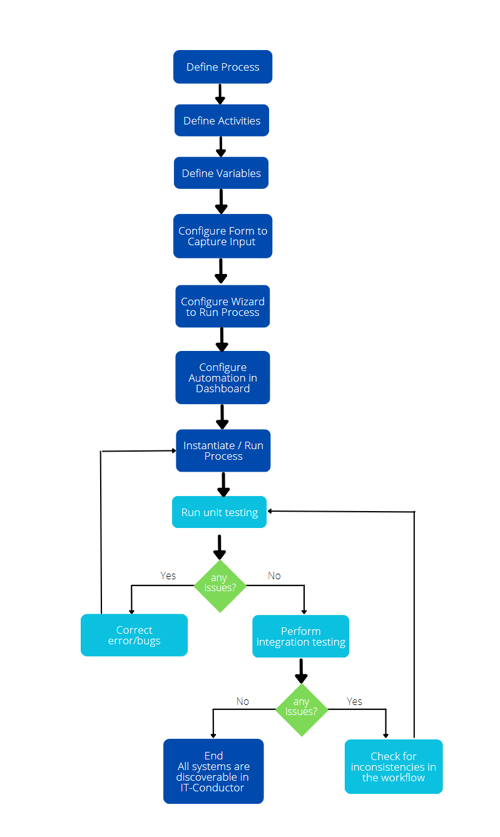In 2023, artificial intelligence (AI) and automation have been among the most discussed topics globally, and we can't deny that they have simplified our lives and work to a certain degree. Automation is a great way to increase efficiency, cut corners when possible, and reduce costs, but it should never come at the expense of quality. Quality assurance (QA) plays a critical role in making sure that automated solutions are accurate and reliable.
As we all know, quality assurance is the process of testing and validating software applications, with the purpose of verifying that they meet the requirements that we previously set for them and comply with industry standards. The overall purpose of executing a QA process in automation is to make sure that the solution works as expected while providing valuable feedback and insights into its performance. This blog post will explore the importance of having a well-defined QA process when performing automation projects, as well as the key steps needed to get started.
The benefits of incorporating a QA process in an automation project
Automation comes with many benefits, but it also comes with certain risks and challenges that must be addressed. One of the most important steps in mitigating these risks is implementing a QA process into your projects.
It ensures security and compliance with industry standards
It allows teams to make sure that all data collected during the automation processes are secure and compliant with relevant regulations. It also ensures that users are getting exactly what they expect from an automated solution – nothing less than what was promised.
Reduce time and cost associated with development cycles
Automated solutions are designed to be more efficient than manual processes, but without a well-defined QA process, there is no way to guarantee the accuracy and reliability of these solutions. In addition, if errors or bugs go undetected until after the solution has been released, they can be costly and time-consuming to fix. Having a comprehensive QA process in place can help detect issues early on so that they can be addressed quickly before release.
Spotting improvement opportunities
QA processes aren’t there just to search and fix bugs. They’re also opportunities for improvement. They allow teams to optimize their automated solutions for maximum efficiency. If possible, you should bring a fresh pair of eyes to the QA process. This can be a supervisor or a manager who’s not a dedicated member of the QA team, as they’ll be able to offer feedback from a whole new perspective. Having this detailed feedback allows teams to better understand the effectiveness of their automated solutions and know if additional features should be added or removed.
Improve overall project quality
Incorporating user feedback throughout the testing phase can help improve user experience. As we explained in the previous point, the QA process is also when fresh, new ideas rise to the surface. They’re a chance to think outside of the box in hopes of not just meeting requirements, but exceeding customer expectations. By taking on tasks that can be easily (or not so easily) automated you improve the project’s overall quality, whilst helping remain competitive in this digital age.
Involving QA steps in your Automation Projects
First and foremost, the QA process should incorporate a comprehensive analysis of the project requirements. Periodic reviews of test results must also take place, especially following any code changes or improvements. You must also define the specific types of tests to be performed, such as unit tests, integration tests, system tests, performance tests, security tests, user acceptance tests, and regression tests, and perform them as necessary. The number of tests required may vary based on the complexity of the project, but at the very least, unit and integration testing should be included in every test plan.
 Figure 1: Unified Workflow of Automation and QA Steps
Figure 1: Unified Workflow of Automation and QA Steps
As part of this process, it is crucial for QA teams to document all encountered failed scenarios encountered during testing, as well as keep track of the progress. This practice ensures that any issues do not impede delivery timelines or compromise the user experience. Should such issues occur, teams will be able to foresee them and plan accordingly.
To demonstrate this process, we will utilize one of IT-Conductor’s automation features—a workflow for start/stop automation, including the testing phases. While this example focuses on the first two stages of testing (unit and integration), the principles apply to broader contexts.
 Figure 2: QA Workflow for Start DB Procedure
Figure 2: QA Workflow for Start DB Procedure
Figure 3: Start/Stop Automation Dashboard in IT-Conductor
Like with any other project, the most important element is setting up a clear communication system between developers and testers, so progress can be tracked accurately and any issues identified quickly.
Getting Started
Step 1: Define Objectives
The first step in setting up a QA process for automation is to define and understand the objectives of your project. What are you trying to accomplish? Are you creating an automated solution that is reliable, secure, and user-friendly? Setting clear objectives from the outset will help guide your development process.
Step 2: Create a Test Plan
Once you have identified your objectives, it's time to create a test plan. This should include detailed instructions on how to perform the test, as well as the acceptance criteria that must be met in order to pass the tests. Additionally, you should consider any potential risks or issues such as security flaws or bugs that could compromise the test, and be on the lookout for those.
Step 3: Test
It’s time to set your test plan in motion. Depending on the complexity of the project, this can involve setting up the systems before any testing can begin. Make sure to document every part of the progress so any issues can be quickly identified and addressed before they become more serious problems down the line. Remember: Even though you find bugs and errors during the testing phase, there’s no such thing as an unsuccessful QA process. In fact, it’s probably better that your team finds it rather than the customer.
Step 4: Monitor Performance
The final step is monitoring your automated solution’s performance over time. This involves collecting data on how the solution is performing, looking out for any potential risks or issues that need addressing, as well as ensuring customer satisfaction. By following these steps regularly, you can make sure that your solution remains competitive in the market while also improving customer experience.
In conclusion, a complete QA process for automation projects consists of a constant review of test outcomes, lots of progress tracking sheets, a lot of communication between team members, and listing encountered failed tests. All with the purpose of preventing regression and minimizing service disruption, and guaranteeing a successful release.



